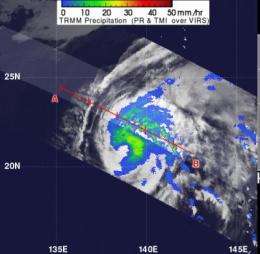NASA's TRMM satellite sees some heavy rainfall in Typhoon Sanvu

Tropical Storm Sanvu strengthened overnight as forecast and is now a Typhoon in the western North Pacific Ocean. NASA's Tropical Rainfall Measuring Mission (TRMM) satellite observed that most of the rainfall is falling in the eastern half of the storm.
The TRMM satellite measured the rainfall from Typhoon Sanvu on May 24, 2012.TRMM's Microwave Imager (TMI) and Precipitation Radar (PR) data shows that Sanvu's heaviest rainfall was occurring in its northeastern quadrant where some intense storms were dropping rainfall at a rate greater than 50mm/hr (~2 inches/hr). TRMM shows that the rainfall wraps around the eastern side of the storm, stretching from north to south, while the western side of the storm is deficient in rainfall.
On May 24 at 1500 UTC (11 a.m. EDT/U.S.), Typhoon Sanvu had maximum sustained winds near 65 knots (75 mph/120.4 kph). It was about 275 nautical miles south-southwest of Iwo To, Japan, near 21.2 North and 138.9 East. Sanvu is causing high waves throughout the region, and waves have been estimated as high as 29 feet (8.8 meters). It is moving to the north at 9 knots (10.3 mph/16.6 kph).
Forecasters at the Joint Typhoon Warning Center now forecast the Sanvu will likely take a track very close to the island of Iwo To, Japan early on May 26. Iwo To was reporting thunderstorms and winds from the east-southeast by mid-day (U.S. EDT) on May 24 (May 25 local time) which are associated with the east-southeasterly flow from the approaching typhoon. As Sanvu continues to approach, thunderstorms from the typhoon will be affecting the island on May 26.
Provided by NASA's Goddard Space Flight Center




















